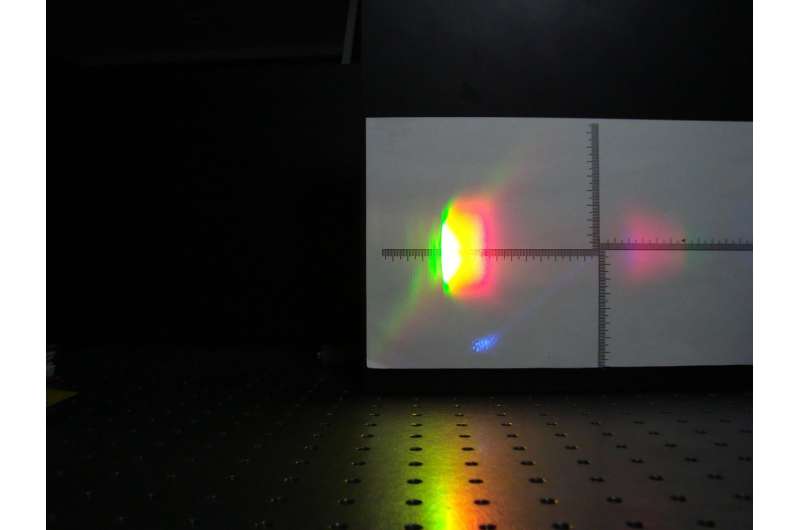Photo of the scattering picture. Credit: Pavel Prudkovskii
A team from the Faculty of Physics, MSU, has developed a method for creating two beams of entangled photons to measure the delay between them. In the future the results of the study may be used in high-precision measurements, material studies, and informational technologies. The article was published in Optics Letters journal.
David Nikolaevich Klyshko, professor of the Chair of Quantum Electronics at MSU, discovered spontaneous parametric down conversion in 1966 and was later awarded the State Prize along with his colleagues. This discovery marked the beginning of quantum optics, a popular area of physics involving quantum properties of light. The effect is quite simple: A photon that enters a crystal is divided into two photons with the sum of their frequencies equal to the frequency of the original photon. Notably, this process may be observed only in non-linear crystals in which the frequency of photons may change in the course of scattering.
The effect has been observed in studies of the crystals themselves, measurements of efficiency in light-sensitive detectors, and especially in quantum optics, where it has practical applications in such fields as quantum cryptography, quantum calculations, and quantum teleportation. If the polarization of one photon is measured, the quantum state of polarization of the second one is altered, as well. Any changes in the first photon immediately occur in the second one. However, this effect cannot be used to exchange information.
In a recent experiment, MSU-based scientists under the guidance of leading research associate Maria Chekhova tried to generate powerful beams of entangled photons. "In this case, the correlation is not between individual photons, but the whole beams, and the question is, what is the precision of this correlation?" says Pavel Prudkovskii, a co-author of the work. "If we slow one beam down, at what point in time would we notice the desynchronization?"
To answer these questions the scientists had to make photons with different frequencies to form two beams of light moving together in parallel. In order to obtain this effect, lithium niobate crystals that are often used in such experiments had to be grown with a certain structure with a pre-calculated additional non-periodic domain lattice.
In the course of the experiment, the scientists made one of the two entangled photon beams stall a little, and travel along an auxiliary path. Then, both beams reached the second crystal—the usual lithium niobate. "In this crystal, the summation of frequencies took place. If the beams arrive in sync, it is more efficient than in other cases," said Prudkovskii. "As a result, we get a narrow peak in the summary frequency signal. The width of it is 90 femtoseconds (10 -15 sec), and this is our main achievement.
Thus, the scientists managed to experimentally register the smallest possible shift between twin beams of entangled photons that may be observed by measurement devices. According to the team, it is possible to further reduce this value, but to do so, the scheme of the experiment would be more complex. "Right now, 90 femtoseconds is a record-setting value, but it can be reduced, and we know how," explained Prudkovskii. He says that the wave period of laser emission is only several femtoseconds, so it is possible to reduce the length of such a delay down to a dozen or so.
The results of the study may be used for the development of encrypted communication channels protected from interruptions or bugging. If a criminal tries to intercept a beam of entangled photons, they would have to stall it for a period of time, and the delay would be noticed. Moreover, the registration of a delay in two quantum-entangled beams may be used to detect minor admixtures in substances.
More information: Maria V. Chekhova et al, Broadband bright twin beams and their upconversion, Optics Letters (2018). DOI: 10.1364/OL.43.000375
Journal information: Optics Letters
Provided by Lomonosov Moscow State University























